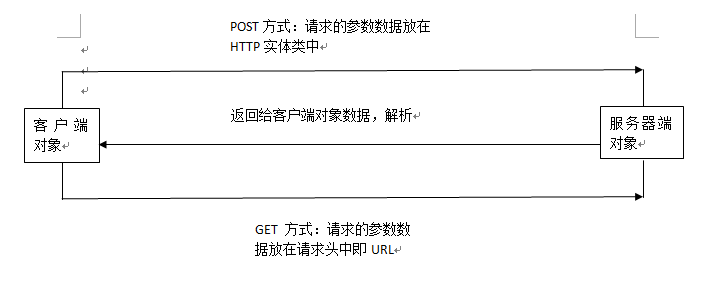Android客户端post请求服务器端实例
2015-06-05 11:07
851 查看
Android客户端请求服务器端的详细解释
1. Android客户端与服务器端通信方式:
Android与服务器通信通常采用HTTP通信方式和Socket通信方式,而HTTP通信方式又分get和post两种方式。
2. 解析服务器端返回数据的解释:
(1).对于服务器端来说,返回给客户端的数据格式一般分为html、xml和json这三种格式。
(2). JSON(Javascript Object Notation)是一种轻量级的数据交换格式,相比于xml这种数据交换格式来说,因为解析xml比较的复杂,而且需要编写大段的代码,所以客户端和服务器的数据交换格式往往通过JSON来进行交换。
3. Android中,用GET和POST访问http资源
(1).客户端向服务器端发送请求的时候,向服务器端传送了一个数据块,也就是请求信息。
(2). GET和POST区别:
A: GET请求请提交的数据放置在HTTP请求协议头(也就是url)中,而POST提交的数据则放在实体数据中,安全性比较高。
B: GET方式提交的数据最多只能有1024字节,而POST则没有此限制。

注意:考虑到POST的优势,在Android开发中自己认为最好用POST的请求方式,所以下面自己写了一个小的POST请求的例子。代码如下:
package com.scd.jsondemo.util;
import java.io.IOException;
import java.io.UnsupportedEncodingException;
import java.util.ArrayList;
import java.util.List;
import org.apache.http.HttpEntity;
import org.apache.http.HttpResponse;
import org.apache.http.NameValuePair;
import org.apache.http.client.ClientProtocolException;
import org.apache.http.client.HttpClient;
import org.apache.http.client.entity.UrlEncodedFormEntity;
import org.apache.http.client.methods.HttpPost;
import org.apache.http.impl.client.DefaultHttpClient;
import org.apache.http.message.BasicNameValuePair;
import org.apache.http.protocol.HTTP;
import org.apache.http.util.EntityUtils;
import org.json.JSONException;
import org.json.JSONObject;
public class JsonUtil {
/** 地址 */
private static final String INNER_URL = "http://localhost:8080/index2.jsp";
/** TAG */
private final String TAG = getClass().getSimpleName();
private static final int USER_ID = 1;
/***
* 客户端调用的方法:传递参数向服务器中发送请求
*
* @param userId
* @param userName
* @return
*/
public static JSONObject getData(String userId, String userName) {
int modelId = USER_ID;
List<NameValuePair> list = new ArrayList<NameValuePair>();
list.add(new BasicNameValuePair("userId", userId));
list.add(new BasicNameValuePair("userName", userName));
return doPost(modelId, list);
}
/**
* 请求服务器的方法
*
* @param model
* @param paramList
* @return
*/
private static JSONObject doPost(int model, List<NameValuePair> paramList) {
// 1.创建请求对象
HttpPost httpPost = new HttpPost(INNER_URL);
// post请求方式数据放在实体类中
HttpEntity entity = null;
try {
entity = new UrlEncodedFormEntity(paramList, HTTP.UTF_8);
httpPost.setEntity(entity);
} catch (UnsupportedEncodingException e1) {
e1.printStackTrace();
}
// 2.创建客户端对象
HttpClient httpClient = new DefaultHttpClient();
// 3.客户端带着请求对象请求服务器端
try {
// 服务器端返回请求的数据
HttpResponse httpResponse = httpClient.execute(httpPost);
// 解析请求返回的数据
if (httpResponse != null
&& httpResponse.getStatusLine().getStatusCode() == 200) {
String element = EntityUtils.toString(httpResponse.getEntity(),
HTTP.UTF_8);
if (element.startsWith("{")) {
try {
return new JSONObject(element);
} catch (JSONException e) {
e.printStackTrace();
}
}
}
} catch (ClientProtocolException e) {
e.printStackTrace();
} catch (IOException e) {
e.printStackTrace();
}
return null;
}
}
您可能感兴趣的文章:
- android客户端从服务器端获取json数据并解析的实现代码
- Android编程之客户端通过socket与服务器通信的方法
- android异步请求服务器数据示例
- Android编程向服务器发送请求时出现中文乱码问题的解决方法
- Android解析服务器端发来的xml数据示例
- Android TCP 文件客户端与服务器DEMO介绍
- Android使用httpPost向服务器发送请求的方法
- Android程序开发通过HttpURLConnection上传文件到服务器
- Android封装的http请求实用工具类
- android实用工具类分享(获取内存/检查网络/屏幕高度/手机分辨率)
- Android开发实现查询远程服务器的工具类QueryUtils完整实例
相关文章推荐
- 使用C++实现JNI接口需要注意的事项
- Android IPC进程间通讯机制
- Android Manifest 用法
- [转载]Activity中ConfigChanges属性的用法
- Android之获取手机上的图片和视频缩略图thumbnails
- Android之使用Http协议实现文件上传功能
- Android学习笔记(二九):嵌入浏览器
- android string.xml文件中的整型和string型代替
- i-jetty环境搭配与编译
- android之定时器AlarmManager
- android wifi 无线调试
- Android Native 绘图方法
- Android java 与 javascript互访(相互调用)的方法例子
- android 代码实现控件之间的间距
- android FragmentPagerAdapter的“标准”配置
- Android"解决"onTouch和onClick的冲突问题
- android:installLocation简析
- android searchView的关闭事件
- SourceProvider.getJniDirectories
